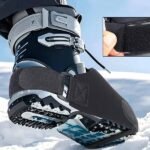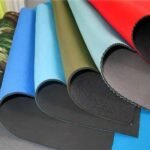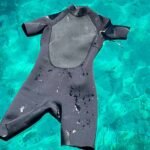Have you ever hesitated before heading into the water because you weren’t sure if your wetsuit would keep you warm enough? I used to worry about being too cold during my water activities and even had to cut short some adventures because of it. As someone with decades of experience in manufacturing high-quality neoprene wetsuits for leading brands and retailers in Europe, North America, and Australia, I know exactly how the thickness of a wetsuit affects thermal performance. In this article, I will answer key questions about a 3mm wetsuit—from its ideal temperature range to its overall performance—so you can confidently choose the right product for your market.
A 3mm wetsuit is most effective in water temperatures between 65°F and 75°F (18°C to 24°C). It strikes a balanced mix between warmth and flexibility, making it popular for moderate conditions. Designed with high-quality neoprene, it traps a thin, warmed layer of water against your skin, ensuring steady insulation throughout your activity.
Imagine being out on the water, completely comfortable and confident that your wetsuit will keep you warm without restricting your movement. Below, I answer important questions about 3mm wetsuits, discuss their temperature range, and examine their performance across various water activities. This guide will help you decide whether a 3mm wetsuit fits the needs of your customers.
What Is a 3mm Wetsuit?
What defines a 3mm wetsuit, and what makes it stand apart from other thicknesses? I have received many inquiries from clients wondering about its construction and design.
A 3mm wetsuit is constructed from premium neoprene that is precisely 3 millimeters thick. It is designed to trap a thin layer of water between your skin and the suit, which then warms up due to your body heat. This simple yet effective mechanism provides the wearer with moderate thermal insulation ideal for temperate water conditions.
Understanding the Components
Neoprene Composition
-
Chemical Composition:
Neoprene is made from chloroprene, a synthetic monomer that is polymerized to create a resilient rubber. This process gives the material its characteristic elasticity and durability. -
Closed-Cell Structure:
The structure of neoprene is composed of thousands of small, closed cells that lock in air. This trapped air layer is essential for the insulation process, as it helps to slow the loss of body heat.
Construction Techniques
-
Seam Methods:
Advanced seam techniques, such as glued and blind-stitched construction, minimize water entry. This ensures that the insulation layer is preserved even during vigorous activity. -
Lining Materials:
Many 3mm wetsuits incorporate a smooth inner lining that enhances comfort and may provide a small boost to thermal performance by reducing the friction between your body and the neoprene.
| Aspect | Details |
|---|---|
| Thickness | 3 millimeters |
| Material | High-quality neoprene (chloroprene-based) |
| Seams | Glued and blind-stitched for minimal water entry |
| Insulation | Closed-cell structure that traps a heated water layer |
What temperature is a 3mm wetsuit for?
What are the optimal water temperature conditions for wearing a 3mm wetsuit? I have found this question to be central among both new and experienced users alike.
3mm wetsuits are best suited for water temperatures ranging from 65°F to 75°F (18°C to 24°C). In this range, the suit delivers enough insulation to keep you warm while still offering flexibility and comfort. This balance makes it a popular choice for surfers, snorkelers, and casual swimmers alike.
Temperature Range and Performance
Factors Influencing the Temperature Range
-
Ambient Water Temperature:
The primary factor is the temperature of the water. In environments within 65°F-75°F, the suit works optimally to keep a warm water layer next to the body. -
User Activity Level:
Activity helps generate additional heat. For individuals engaging in vigorous water sports, even slightly cooler waters may be tolerable as the body’s metabolic heat contributes to overall warmth. -
Wind and Air Exposure:
If the water is calm and there is little wind, a 3mm wetsuit will perform closer to its peak efficiency. Higher winds can increase heat loss, but proper fit and design help minimize this effect.
Testing and Validation
-
Field Testing:
Many manufacturers conduct real-world testing with athletes and recreational users to identify the performance of wetsuits in specific temperature ranges. -
User Feedback:
Consistent feedback from users in moderate temperature zones underpins the recommendation that a 3mm wetsuit is best for waters between 65°F and 75°F.
| Temperature Range | Ideal Conditions |
|---|---|
| 65°F – 75°F | Recreational water sports, surfing, snorkeling |
| Below 65°F | Additional insulation or accessories required |
| Above 75°F | Lighter suits may be more suitable |
Is a 3mm wetsuit warm enough for winter?
Is it realistic to depend on a 3mm wetsuit in winter waters? I have addressed many concerns regarding the suitability of 3mm wetsuits for colder climates.
For many winter conditions where water temperatures can drop below 65°F (18°C), a 3mm wetsuit may not offer sufficient warmth on its own. It is better suited for moderate conditions. However, with the addition of accessories like hoods, gloves, or booties, it can be adapted for cooler winter use in less extreme environments.
Evaluating Winter Performance
Key Considerations
-
Water Temperature:
In winter, water temperatures often fall below 65°F. In such cases, a thicker wetsuit is typically recommended for extended exposure. -
Supplementary Gear:
Accessories such as neoprene hoods, gloves, and booties can significantly enhance warmth. These are essential when a 3mm wetsuit is used in borderline conditions. -
Activity Intensity:
High-intensity activities generate extra body heat that can help offset cooler water temperatures, though this is usually not enough for prolonged exposure.
Practical Scenarios
-
Mild Winter Days:
In coastal areas with relatively mild winters, a 3mm wetsuit combined with a hood might suffice. -
Extreme Winter Conditions:
In very cold waters, the limitations of a 3mm suit become apparent, and users might need to look at thicker options, such as a 5mm or even 7mm wetsuit.
| Condition | Suitability |
|---|---|
| Moderate Winter | 3mm may work with additional gear |
| Harsh Winter | 3mm is typically insufficient; consider thicker suits |
Expert Insights
- Professional Recommendations:
Experts frequently advise that while a 3mm wetsuit is excellent for temperate conditions, winter use often demands additional insulation.
How Does the Thickness of 3mm Impact Warmth and Flexibility?
How does a 3mm thickness provide a balance between thermal insulation and mobility? This is a critical consideration for those who engage in dynamic water sports.
A 3mm wetsuit strikes a balance; its thickness is sufficient to trap a stable layer of warm water for insulation while remaining thin enough to offer excellent flexibility. This ensures that movements remain unrestricted, making it ideal for active sports like surfing and snorkeling.
Detailed Impact Analysis
Balancing Act: Insulation Versus Flexibility
-
Insulation:
The 3mm thickness creates a boundary that minimizes heat loss. Its closed-cell structure traps a thin, heated water layer against your skin, acting as an insulative barrier. -
Flexibility:
A thinner suit (compared to 5mm or 7mm versions) allows for greater freedom of movement. This is particularly important in sports where agility and comfort are critical. -
Material Properties:
High-quality neoprene is engineered to retain its elasticity over time. This means that even after extensive use, a 3mm wetsuit will not become overly stiff or constrictive.
Comparative Analysis
| Aspect | 3mm Wetsuit | Thicker Alternatives (e.g., 5mm) |
|---|---|---|
| Thermal Insulation | Moderate; works best in temperate water | Higher; suitable for very cold water |
| Flexibility | Excellent; allows full range of motion | Reduced flexibility due to extra bulk |
| User Comfort | Ideal for active water sports | May feel restrictive during vigorous activity |
Usage Examples
- Surfing and Snorkeling:
The high mobility provided by a 3mm wetsuit is crucial for sports where movement is continuous and vigorous. - Recreational Swimming:
For leisure activities, the balance of warmth and flexibility ensures comfort for extended periods in moderate conditions.
Do 3mm Wetsuits Provide Consistent Thermal Protection?
Do these wetsuits maintain their insulation properties throughout prolonged use? Users often question the reliability of a 3mm suit over time.
Yes, when made with quality materials and proper construction techniques, 3mm wetsuits provide consistent thermal protection. Their design minimizes water exchange, meaning the thin layer of warm water remains stable during use, keeping you consistently insulated.
Assessing Consistency in Thermal Performance
Design and Construction Factors
-
Seam Sealing Techniques:
High-quality seam construction reduces water ingress. Techniques such as glued and blind stitching ensure that the suit retains its insulative properties even after repeated use. -
Material Durability:
Neoprene is built to withstand stretching and compression without losing its shape or thickness, which is critical for maintaining consistent insulation. -
User Experience:
Field tests and feedback from athletes confirm that well-made 3mm wetsuits remain effective for long sessions in the water.
Data and Testing
| Metric | Observation |
|---|---|
| Water Exchange Rate | Minimal in high-quality 3mm wetsuits |
| Durability | Maintains thickness and elasticity over time |
| Consistency | Uniform heat retention reported by repeat users |
Maintenance Best Practices
- Cleaning and Storage:
Proper care, including regular cleaning and correct storage, plays a significant role in preserving the wetsuit’s insulation. - Inspection:
Regular inspection for seam integrity and material wear helps ensure long-term performance.
Is a 3mm Wetsuit Suitable for Different Water Activities?
Is the versatility of a 3mm wetsuit broad enough to cover various water sports? Many brands seek a one-size-fits-all approach for different user needs.
A 3mm wetsuit is versatile and works well for a wide range of water activities, including surfing, snorkeling, and recreational swimming. However, its suitability depends on the specific water conditions and the intensity of the activity. For highly demanding or colder environments, additional measures or thicker suits may be needed.
Activity and Environment Compatibility
Versatility Factors
- Multiple Sports:
The balance of insulation and flexibility makes 3mm ideal for sports where both mobility and moderate warmth are required. - Customization Options:
Custom enhancements in design can further optimize a 3mm suit for specific activities. For instance, reinforcing panels and customized seam placements can improve performance for intense surfing or diving.
Practical Examples
- Surfing:
The high flexibility allows surfers to move freely, while the moderate insulation provides comfort in typical ocean water temperatures. - Snorkeling:
For snorkeling, a 3mm suit offers enough warmth without sacrificing the ease of movement required for exploring shallow waters. - Recreational Swimming:
In casual swimming, the suit maintains comfort during long sessions, provided water temperatures remain within the ideal range.
| Activity | 3mm Suit Suitability |
|---|---|
| Surfing | Excellent flexibility and moderate warmth |
| Snorkeling | Ideal for warmth in shallow, moderate-temperature water |
| Recreational Swimming | Provides comfort and sufficient insulation |
| Diving | May require additional gear if water is very cold |
Do I need a 3mm or 5mm wetsuit?
Do I choose a 3mm or a 5mm wetsuit for my water activities? This is an essential decision based on temperature needs and activity levels.
A 3mm wetsuit is best for moderate water temperatures (65°F-75°F) where flexibility is as important as warmth. In contrast, a 5mm wetsuit is designed for colder conditions, offering enhanced insulation but reduced mobility. The choice ultimately depends on the environment, activity intensity, and user preferences.
Comparing 3mm and 5mm Wetsuits
Side-by-Side Comparison
-
Temperature Range:
3mm suits are ideal for temperate conditions, whereas 5mm suits are meant for waters below 65°F (18°C). -
Mobility versus Insulation:
3mm offers greater freedom of movement for active sports. Meanwhile, 5mm provides superior insulation for extended exposure to cold water. -
User Feedback:
Many users report that a 3mm suit is perfect for summer and early fall, while a 5mm suit is preferred during winter or in high-altitude lakes.
| Wetsuit Thickness | Ideal Conditions | Key Benefits |
|---|---|---|
| 3mm | 65°F-75°F (18°C-24°C) | Balance of flexibility and moderate insulation |
| 5mm | Below 65°F (under 18°C) | Enhanced insulation for colder water |
Decision Criteria
- Activity Type:
Consider whether the activity requires rapid movement or prolonged stationary exposure. - Water Conditions:
Evaluate the water temperature and expected duration of exposure. - Custom Solutions:
Remember that our custom wetsuit options allow you to fine-tune features for specific needs, bridging the gap between standard 3mm and 5mm designs.
Conclusion
In this article, I have provided an in-depth exploration of the performance of 3mm wetsuits. We discussed what a 3mm wetsuit is and how it works, established that it performs best in water temperatures between 65°F and 75°F (18°C to 24°C), and examined its limitations in very cold water. I explained how the 3mm thickness offers an ideal balance between warmth and flexibility, ensuring consistent thermal protection and versatility for various water activities. Finally, I compared the suitability of 3mm against 5mm wetsuits based on environmental conditions and user requirements.
At Szoneier, our advanced manufacturing capabilities and decades of expertise allow us to produce custom neoprene wetsuits that meet the specific needs of our clients worldwide. We cater to brand owners, wholesalers, and large retailers in Europe, North America, and Australia. If you value high quality, durability, and performance in your wetsuit products, please contact us.











